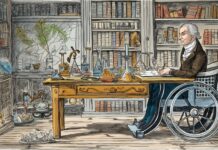Zanimiv in nazoren prikaz Chladnijevih vzorcev na nihajoči plošči. Vzorci se imenujejo po nemškem fiziku Ernstu Chladniju, ki jih je prvi sistematično preučeval, matematično pa jih je prva pojasnila Sophie Germain.
One of Chladni’s best-known achievements was inventing a technique to show the various modes of vibration of a rigid surface. When resonating, a plate or membrane is divided into regions that vibrate in opposite directions, bounded by lines where no vibration occurs (nodal lines). Chladni repeated the pioneering experiments of Robert Hooke who, on July 8, 1680, had observed the nodal patterns associated with the vibrations of glass plates. Hooke ran a violin bow along the edge of a plate covered with flour and saw the nodal patterns emerge.
Chladni’s technique, first published in 1787 in his book Entdeckungen über die Theorie des Klanges (“Discoveries in the Theory of Sound”), consisted of drawing a bow over a piece of metal whose surface was lightly covered with sand. The plate was bowed until it reached resonance, when the vibration causes the sand to move and concentrate along the nodal lines where the surface is still, outlining the nodal lines. The patterns formed by these lines are what are now called Chladni figures. Similar nodal patterns can also be found by assembling microscale materials on Faraday waves.
When Chladni showed the technique in Paris, Napoleon set a prize for the best mathematical explanation. Sophie Germain’s answer, although rejected due to flaws, was the only entry with the correct approach.







